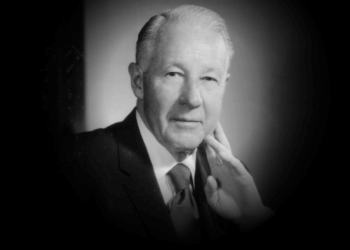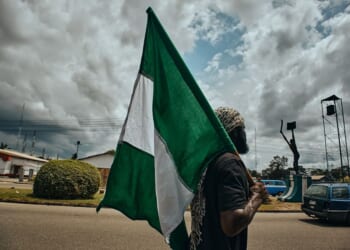At 8:15 a.m. on Wednesday, a hush falls over the crowd gathered in Hiroshima’s Peace Memorial Park. As volunteers strike a bell, the park’s Flame of Peace sends ripples through the remains of the Hiroshima Prefectural Industrial Promotion Hall – the only building left standing when the United States dropped a nuclear bomb on the Japanese city, at this moment, exactly 80 years ago.
Hiroshima Mayor Matsui Kazumi then speaks about ongoing wars in Ukraine and Gaza, and how many countries are turning to nuclear weapons as a way to feel secure in an increasingly unstable world. These developments “threaten to topple the peace-building frameworks so many have worked so hard to construct,” he tells the crowd.
As the only country in the world to experience a nuclear attack, Japan has always taken its responsibility in advocating against nuclear weapons seriously. Hiroshima and Nagasaki, where the bombs fell directly, have led the way. But on the 80th anniversary of the bombing of this thriving city where tourism has flourished, as conversations around nonproliferation become less popular globally and the number of living survivors dwindles, some activists in Hiroshima wonder whether the city is as committed to disarmament as it once was.
Why We Wrote This
As the nonproliferation movement enters a tenuous new era, Japan’s first-hand experience with nuclear warfare is crucial in the fight for a nuclear-free world. Yet, in Hiroshima, activists worry that growing tourism and business interests have overshadowed the city’s commitment.
Amid growing security threats from nuclear-armed neighbors Russia, China, and North Korea, Tokyo’s commitment appears to be waning, as it seeks shelter under the United States’ nuclear umbrella. Nakamura Keiko, an associate professor at Nagasaki University’s Research Center for Nuclear Weapons Abolition, says the Treaty on the Non-Proliferation of Nuclear Weapons is now facing “a serious impasse.”
“Instead of urging the U.S. to pursue further nuclear disarmament, Japan agrees with the U.S. … on strengthening nuclear deterrence,” or using the threat of nuclear retaliation to prevent attacks, Ms. Nakamura says. “Hiroshima and Nagasaki should continue to make a strong appeal that the logic of force against force could lead to nuclear annihilation.”
Cities of peace
On Aug. 6, 1945, an atomic bomb dropped by an America B-29, the Enola Gay, exploded above Hiroshima, about 430 miles west of Tokyo. It obliterated the city, killing tens of thousands instantly, and 140,000 by year’s end.
Three days later, another atomic bomb was detonated over the southwestern city of Nagasaki, with a similarly devastating impact.
The two atomic bombings increased the pressure for Japan to surrender, which it did on Aug. 15, 1945. In the post-World War II era, both Hiroshima and Nagasaki have spearheaded the promotion of nuclear disarmament, and have also protested against nuclear tests overseas. Hiroshima’s aggressive advocacy often overshadowed that of Nagasaki, giving rise to the Japanese saying: “Hiroshima rages, Nagasaki prays.”
However, some activists say that rage is being tempered. Last August, the city’s government effectively barred civic groups from holding their usual anti-war and anti-nuclear protests in the lead-up to the 79th anniversary by restricting access to Peace Memorial Park and banning the use of microphones, instruments, and flyers on the grounds, says anti-war activist Yagi Yasuyuki. Dozens of protestors were forcibly removed from a rally he and other activists organized within the park today, he adds.
The aim of the Aug. 6 ceremony is to “comfort the spirits of the victims of the atomic bombing and pray for the realization of everlasting peace in the world,” the city said in a statement. “Thus, we make efforts to hold it solemnly.”
Yet Mr. Yagi says last year’s crackdown was a first for Hiroshima.
Hibakusha (atomic-bombing survivors) have long raised their voices against war and nuclear weapons, he argues, “but Mr. Matsui pretends to be totally unaware of their efforts.” Civic groups criticized the mayor for violating the right to freedom of expression, and threatening Hiroshima’s legacy.
Keeping the peace vs. building peace
Moritaki Haruko, daughter of a prominent atomic bomb survivor and leader of the nonprofit group Hiroshima Alliance for Nuclear Weapons Abolition, worries that the local government now prioritizes business and tourism over pushing for total nuclear abolition – what she describes as the “original intention” of the city.
Mayor Matsui has repeatedly urged Tokyo to sign and ratify the Treaty on the Prohibition of Nuclear Weapons, which bans countries from developing or possessing nuclear arms, and unlike the nonproliferation treaty, neither Japan nor the U.S. has signed. However, he has not criticized his supporters in Japan’s ruling Liberal Democratic Party on issues of nuclear energy and safety, and when Prime Minister Ishiba Shigeru emphasized the country’s need for extended nuclear deterrence, Mr. Matsui failed to speak out, says Ms. Moritaki.
The mayor touts overseas tourism and the city’s various redevelopment projects as his administration’s main accomplishments. In 2024, about 2.5 million overseas tourists visited Hiroshima, up 70% from the previous year, according to the city. The sharp increase is largely attributed to a Group of Seven summit that Hiroshima hosted in 2023, says Nakata Norihide, an official at the Hiroshima Chamber of Commerce and Industry.
The event attracted huge international media attention – which city leaders say helps educate the public about the horrors of nuclear war.
When each of the G7 leaders laid a wreath at the arch-shaped Hiroshima Victims Memorial Cenotaph near ground zero, “I was deeply moved because my father is hibakusha,” Mr. Nakata recalls.
Hiroshima’s ‘original intention’
On a recent sweltering afternoon, signs of Hiroshima’s “original intention” abound in and around Peace Memorial Park.
About two dozen students from Eishin Gakuen in Fukuyama organized a petition drive for nuclear abolition around the Hiroshima Prefectural Industrial Promotion Hall, now known as the Atomic Bomb Dome. Yamashiro Miyo, who leads the school’s human rights club, says its members were inspired by stories told by the hibakusha.
At another atomic-bombed building near the Peace Memorial Park, an art and music exhibition called “Reborn” runs through August 6. On display are black-and-white portraits from Miyakaku Takao’s book “Ground Zero Hiroshima Love and Peace,” which show visitors – Japanese and foreigners – closing their eyes in front of the skeletal Atomic Bomb Dome, and thinking about peace.
In front of that same dome, Mito Kosei sits with a collection of newspaper clippings and files of photos and papers. Mr. Mito’s mother, Tomie, was pregnant with him at the time of the bombing, and passed away this year at the age of 106. Armed with her stories and various archives, Mr. Mito waits to answer visitors’ questions in both Japanese and English.
Mr. Mito, who is not affiliated with any particular peace group, says Japanese people generally don’t have a good education about World War II. “If you think you know, that is the biggest pitfall,” Mr. Mito says.
In contrast, he was impressed by recent visitors from the U.S., who approached him with humility. “One of the things visiting Americans would like to know is whether hibakusha have anti-U.S. sentiments,” says Mr. Mito, who tells visitors no – at least not the survivors he’s known. “Americans at that time were victims of their country’s education, as Japanese were.”















